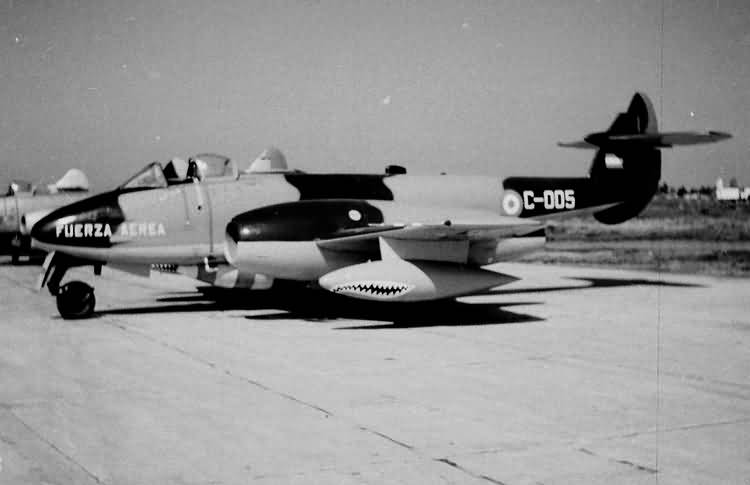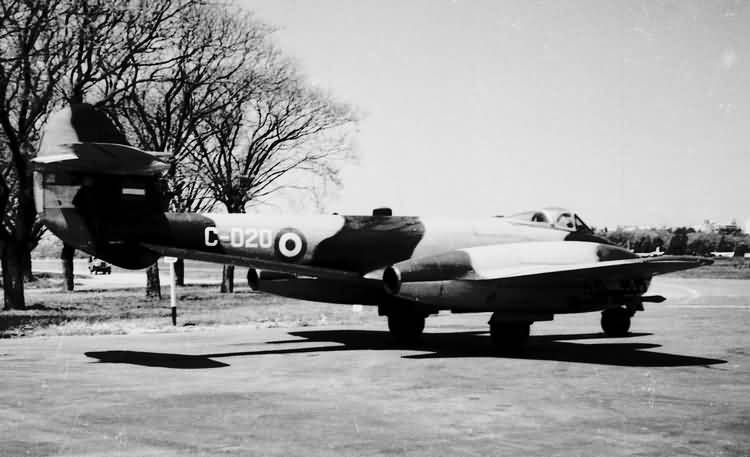From: http://www.vectorsite.net/avmeteor.html
…
[3] G.41 PROTOTYPES / METEOR MARK I
…
The first Meteor to actually fly took to the air on 5 March 1943, with Michael Daunt at the controls. It was the fifth in the prototype manufacturing sequence and was fitted with de Havilland Halford H.1 turbojets, the ancestor of the Goblin. This particular engine fit led to the sixth prototype, which flew on 12 July 1945 and featured full-development de Havilland Goblin engines. The sixth prototype was to lead to a “Meteor Mark II (G-41B)” series. However, de Havilland wanted to reserve Goblin production for their Vampire fighter. The Meteor Mark II didn’t enter production, and operational Meteors would never feature Goblin engines.
The third prototype featured another unusual engine fit, being powered by MetroVic F.2 axial-flow engines in oversized nacelles. It flew in November 1943, but although other axial-flow engines would be tested on later versions of the Meteor, all operational Meteors would be fitted with centrifugal-flow engines.
The other prototypes were fitted with variations on the W.2B engine, except for the eighth, which was fitted with Rolls-Royce Derwent I engines. This aircraft flew on 18 April 1944, and pointed the way to operational Meteor marks.
- There was uncertainty about production of the Meteor for some time. The jet engines available at the time were clearly “fuel hogs” and the Meteor necessarily had limited range, making it only suitable as a interceptor. Since the bombers of the German Luftwaffe were no longer a real threat to the British Isles, and to the extent that they were they could be dealt with by current fighters, there was no immediate reason to disrupt critical production of existing aircraft to field the Meteor. Test and development of the Meteor continued for the time when it would be needed.
By mid-1943 intelligence reports of new German jet aircraft and missiles indicated that time was coming near, and led to the first production Meteor, the “Mark I (G-41A)”, which was basically used for operational evaluation. 20 were built by Gloster, with the first flying on 12 January 1944. They were fitted with Rolls-Royce W.2B / Welland I engines with 7.55 kN (770 kgp / 1,700 lbf) thrust each. The Meteor I had a “clear-view” canopy instead of the heavy framed canopy of the prototypes.
The Meteor I was fitted with four 20 millimeter Hispano Mark III cannon, though six had been specified in the original G.41 requirement, and in fact one of the prototypes had mounted six. However, one pair of cannon was so mechanically inaccessible that under some circumstances ground crews would have had to remove them while they were still loaded. This was a dangerously accident-prone condition; any experienced military person knows that if stupid accidents can happen, they will, and so those two cannon were deleted, leaving two cannon mounted on either side of the nose. The deletion of the two cannon led to balance problems that required nose ballast, a fix that would get worse before it got better.
The Meteor I was an all-metal aircraft of conventional construction, with low-mounted straight wings with two spars, turbojets mid-mounted in the the wings, and a high-mounted horizontal tailplane to keep it out of the way of the jet exhaust. It had “fence”-style air brakes above and below the wings inboard of the engines to keep the aircraft controllable in a high-speed dive.
The Meteor was designed in a “modular” fashion, a consequence of the fact that it had been originally ordered during the Battle of Britain, when planners had considered the need for “dispersed production”, with different factories building different subassemblies of the aircraft for final assembly at a central location. This basic scheme was retained in later versions, making the Meteor easy to transport, repair, and salvage.
The Meteor had tricycle landing gear, which were shorter than those for a piston aircraft since there was no propeller to divot up the ground. A mechanical indicator popped up from the nose when the nose gear was down to alert the pilot. The cockpit was pressurized and mounted well forward. An external tank, with a capacity of 477 liters (126 US gallons) could be bolted on to the belly of the aircraft.
The first Meteor I was traded to the US for a Bell XP-59A Airacomet, the first American jet aircraft, for comparative evaluation. A few Mark Is were retained for development work in Britain. Of these aircraft, one of the most interesting was the 18th Meteor I, which became the “Trent Meteor”. This was the world’s first turboprop-powered aircraft and was flown on 20 September 1945. It was powered by Rolls-Royce Trent engines, which were basically Derwent IIs hastily fitted with a gearbox system to drive propellers. This engine of course had no direct connection to the later series of Rolls-Royce Trent high-bypass turbofans.
- The rest of the Meteor Is entered RAF squadron service beginning in July 1944 with RAF Number 616 Squadron. The Meteor I was no faster than contemporary piston-engine fighters at high altitude, but unlike them it retained its speed at low altitude, and so was pressed into service to intercept German V-1 flying bombs that summer.
Flying Officer “Dixie” Dean scored the Meteor’s first kill, against such a missile, on 4 August 1944. Dean, his cannons having jammed, maneuvered his aircraft under the wing of the flying bomb to throw it off guidance and into the ground. Another Meteor pilot, Flying Officer J. Roger, shot down another flying bomb later that day with his cannons, and a total of 13 kills were scored with cannon fire into August, when the flying-bomb attacks ceased. This was a very small quantity compared to the total of thousands of flying bomb attacks and kills, but the Meteors served a useful propaganda purpose.
In October, four Meteors participated in exercises designed to develop defensive tactics for Allied bomber formations under attack by Luftwaffe jets. The final report from the exercises provided recommendations for appropriate tactics, but concluded that stopping the German fighters might be very difficult. In operational practice, however, the tactics proved highly effective.
The Meteor I was underpowered, had heavy controls, and pilots complained about the poor view to the sides and rear. The cannon suffered from jams, which turned out to be caused by the spent links from the ammunition belts accumulating in the ejection chutes. The jamming problem was quickly resolved, but there were doubters in the RAF that the newfangled Meteor was the way of the future. Others believed the type had considerable potential, The believers would be proven right.
[4] METEOR MARK III
- The Meteor “Mark III (G-41C)” was the first variant to go into full production. 210 were built, with initial deliveries to the RAF beginning in December 1944 and the last of the variant rolled out in 1947. The Meteor Is were all quickly replaced by Meteor IIIs.
The Meteor III featured a stronger airframe, greater internal fuel capacity, and a rear-sliding canopy, as opposed to the side-hinged canopy of the Meteor I. The first 15 Meteor IIIs were powered by Rolls-Royce W.2B / Welland I turbojets, but the rest were fitted with Rolls-Royce Derwent I turbojets with 8.83 kN (900 kgp / 2,000 lbf) thrust each. The heavier engines increased the balance problem, and the solution was to add yet more ballast.
The pilots appreciated the additional power provided by the Meteor III relative to the Meteor I, as well as the improved view with the new canopy. However, the ailerons had been deliberately wired to be “heavy” to prevent aerobatic maneuvers from overstressing the wings, and pilots complained that maneuvers in the aircraft were very tiring. This had not been a problem with the Meteor I, since it hadn’t been cleared for aerobatic maneuvers. Pilots also complained that the machine tended to “snake” at high speed, limiting its accuracy as a gun platform, and it tended to become uncontrollable in a dive due to compressibility buffeting. However, the aircraft was basically liked. A flight combat exercise against the excellent Hawker Tempest V piston fighter concluded:
“The Meteor III is superior to the Tempest V in almost all departments. If it were not for the heaviness of its ailerons and the consequent poor maneuverability in the rolling plane, and the adverse effect of snaking on it as a gun platform, it would be a comparable all-round fighter with greatly increased performance.”









